From the Field: Bill Buck in Cape Horn 2013, Day Three
Posted in Bill Buck, From the Field, Science on February 21 2013, by William R. Buck
January 12, 2013, Prov. Antártica Chilena, Comuna Cabo de Hornos, Parque Nacional Alberto de Agostini, Isla Gordon, Bahía Tres Brazos, 54°59’S, 69°45’W
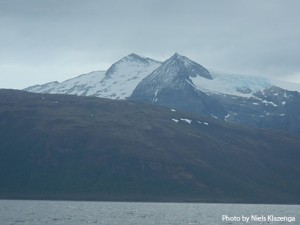 The engines of the ship start at 5 a.m. and, as promised, we get an early start toward our next site. Also as promised, the seas are relatively calm and the bunk room remains a seasickness free zone. I get up at 7 a.m., but when I get up to the galley it is still dark with sleeping crew (after all, their beds had been occupied by oil-body photographers until midnight) and the bathroom is occupied. I tried waiting on deck, but wind and rain chase me into the threshold of the galley where I stand quietly in the dark awaiting my turn. Since there isn’t much point in being up, I return to bed for a couple of hours until there is more activity.
The engines of the ship start at 5 a.m. and, as promised, we get an early start toward our next site. Also as promised, the seas are relatively calm and the bunk room remains a seasickness free zone. I get up at 7 a.m., but when I get up to the galley it is still dark with sleeping crew (after all, their beds had been occupied by oil-body photographers until midnight) and the bathroom is occupied. I tried waiting on deck, but wind and rain chase me into the threshold of the galley where I stand quietly in the dark awaiting my turn. Since there isn’t much point in being up, I return to bed for a couple of hours until there is more activity.
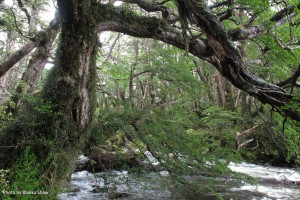 Last year we had a dedicated cook for the whole trip but this year we are told it will be a team effort among three members of the crew. We are initially somewhat apprehensive, but also know the crew themselves won’t tolerate poorly prepared food. It turns out we have nothing to worry about–the two guys who are primarily responsible for the food have proven to be better even than previous years. We get our first fresh bread for breakfast, which completely eliminates our last reservations about the food.
Last year we had a dedicated cook for the whole trip but this year we are told it will be a team effort among three members of the crew. We are initially somewhat apprehensive, but also know the crew themselves won’t tolerate poorly prepared food. It turns out we have nothing to worry about–the two guys who are primarily responsible for the food have proven to be better even than previous years. We get our first fresh bread for breakfast, which completely eliminates our last reservations about the food.
We reach our destination for the day in the early afternoon. This is our second repeat site chosen to show the new people a really mature southern beech forest. Only Laura and I have visited this forest before; it is special enough to show the others and to explore what might have been missed the first time. Much to our delight, the forest doesn’t disappoint.
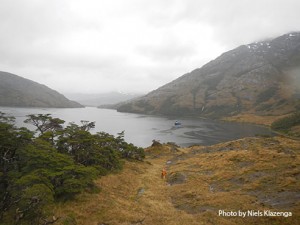 A steady light rain is falling, and almost right away I realize I have overdressed–it is quite warm and I am forced to keep my raincoat unzipped. The epiphyte load in this forest is incredible with its sheltered site and high humidity. I found this site rich last year and want to see what I might have overlooked. I also want a bit more time to look for lichens because my meager lichen collections from previous expeditions have already resulted in two genera new to science as well as several new species. In addition, a group of Spanish lichenologists published a treatment of the lichenicolous fungi a few years ago, so I want to try my luck at finding this group. Over and over I am excited to find the small black fruiting bodies on sick-looking lichens. I know I have collected multiple species and hope that I have managed to come up with some new species.
A steady light rain is falling, and almost right away I realize I have overdressed–it is quite warm and I am forced to keep my raincoat unzipped. The epiphyte load in this forest is incredible with its sheltered site and high humidity. I found this site rich last year and want to see what I might have overlooked. I also want a bit more time to look for lichens because my meager lichen collections from previous expeditions have already resulted in two genera new to science as well as several new species. In addition, a group of Spanish lichenologists published a treatment of the lichenicolous fungi a few years ago, so I want to try my luck at finding this group. Over and over I am excited to find the small black fruiting bodies on sick-looking lichens. I know I have collected multiple species and hope that I have managed to come up with some new species.
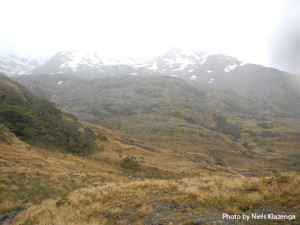 I have arranged for an early retrieval from the field in order to get my first shower of the trip. Although the water is only lukewarm, it is great to wash away the last two days of field grime. In addition I am able to get my specimens processed and put on the dryer, and remove yesterday’s collections before the others return. Most return early as the steady rain has increased in intensity and at least Paddy has found his raingear unsatisfactory (actually he used the word “wretched”). I trust everyone will get used to the weather because hoping for good weather in this part of the world will only result in disappointment!
I have arranged for an early retrieval from the field in order to get my first shower of the trip. Although the water is only lukewarm, it is great to wash away the last two days of field grime. In addition I am able to get my specimens processed and put on the dryer, and remove yesterday’s collections before the others return. Most return early as the steady rain has increased in intensity and at least Paddy has found his raingear unsatisfactory (actually he used the word “wretched”). I trust everyone will get used to the weather because hoping for good weather in this part of the world will only result in disappointment!
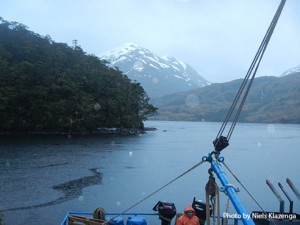 This will be the last site for at least a couple of weeks that will involve returning to sites from previous collecting trips. Starting tomorrow, as we move east, we move into new territory. I have seen many of these sites during visits prior to this flora project, but even Juan has never been to Puerto Williams, the provincial capital. There will be enough new sites to keep my interest up, plus each site will be new to the rest of the group. As we head east we move into drier and drier areas as we follow the precipitation gradient, so hopefully we will see somewhat less rain. However, this also means that we will see some interesting vegetation changes and can expect the ratio of mosses to hepatics to change in favor of the mosses. Needless to say, not everyone is as excited by this as I am.
This will be the last site for at least a couple of weeks that will involve returning to sites from previous collecting trips. Starting tomorrow, as we move east, we move into new territory. I have seen many of these sites during visits prior to this flora project, but even Juan has never been to Puerto Williams, the provincial capital. There will be enough new sites to keep my interest up, plus each site will be new to the rest of the group. As we head east we move into drier and drier areas as we follow the precipitation gradient, so hopefully we will see somewhat less rain. However, this also means that we will see some interesting vegetation changes and can expect the ratio of mosses to hepatics to change in favor of the mosses. Needless to say, not everyone is as excited by this as I am.
Ed. note: NYBG scientist and Mary Flagler Cary Curator of Botany, Bill Buck has just returned from his annual expedition to the islands off Cape Horn, the southernmost point in South America, to study mosses and lichens. For the past two years he was able to file stories from the field, but this year’s locations proved so remote he was forced to wait until his return. We will be publishing them over the course of several days. Follow his journeys on Plant Talk.
Bill Buck’s Previous Reports From the Field:
2013
January 10, 2013, Punta Arenas, Chile
2012
February 5, 2012; Isla Londonderry, Puerto Fortuna, approximately 54º54’S, 70º26’W
February 4, 2012; Isla O’Brien, Caleta Americana, approximately 54º53’S, 70º23’W
February 3, 2012; Isla Grande de Tierra del Fuego, Fiordo Garibaldi, approximately 54º58’S, 69º49’W
February 2, 2012; Isla Gordon, middle arm of Bahía Tres Brazos, approximately 54º58’S, 69º41’W
January 31, 2012; Isla Gordon, Bahía Romanche, 54º57’S, 69º30’W
January 30, 2012; Isla Gordon, Bahía Romanche, 54º57’S, 69º30’W
January 25, 2012; Isla Darwin, Caleta Virginia, approximately 54º57’S, 70º10’W
January 23, 2012; Arm of Estero Webb, SW coast of Isla Hoste, approximately 55º14’S, 69º41’W
January 22, 2012.; Unnamed sound on Isla Gordon behind Cabo El Gorro, approximately 55º02’S, 69º48’W
January 21, 2012; Isla Hoste, Estero Fouque, 55º1’S, 69º35’W
January 20, 2012; Isla Hoste, Estero Fouque, approximately 55º11’S, 69º35’W
January 18, 2012; Canal O’Brien, just south of Isla O’Brien, 54º55’S, 70º35’W
January 17, 2012; Punta Arenas, Chile
2011
July 15, 2011; Hobart, Tasmania, Australia
July 14, 2011; Pyengana, Tasmania, Australia
July 13, 2011; Weldborough, Tasmania, Australia
July 12, 2011; Hobart, Tasmania, Australia
July 11, 2011; Hobart, Tasmania, Australia
February 8, 2011; Punta Arenas, Chile
February 5, 2011, unnamed sound northwest of Isla Georgiana
February 4, 2011, unnamed sound directly east of Seno Mama, Chile
February 2, 2011, Seno Courtenay, northern arm, Chile
February 1, 2011, Seno Courtenay, Chile
January 31, 2011, Canal between Isla Georgiana and Isla Clementina,, Chile
January 30, 2011, Unnamed sound on south side of Brecknock Peninsula, NW of Isla Georgiana, Chile
January 29, 2011, Isla Aguirre, Seno Quo Vadis, Chile
January 26, 2011, Punta Arenas, Chile
January 24, 2011, Seno Chasco, just north of isthmus to Brecknock Peninsula, Chile
January 23, 2011, Isla Grande de la Tierra del Fuego, Puerto Consuelo, Seno Chasco, Chile
January 22, 2011, Isla Grande de la Tierra del Fuego, Seno Brujo, Chile
January 21, 2011, Isla Grande de la Tierra del Fuego, Seno Brujo, Chile
January 20, 2011, Isla Grande de la Tierra del Fuego, Seno Bluff, Chile

